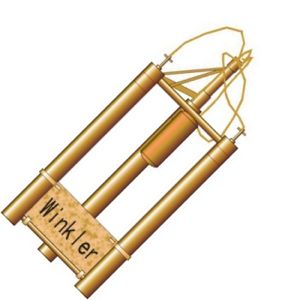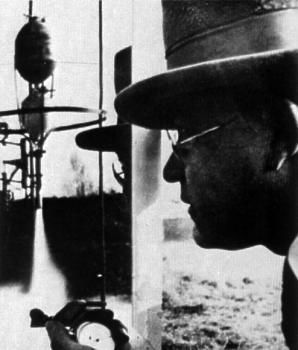
Home - Search - Browse - Alphabetic Index: 0- 1- 2- 3- 4- 5- 6- 7- 8- 9
A- B- C- D- E- F- G- H- I- J- K- L- M- N- O- P- Q- R- S- T- U- V- W- X- Y- Z
HW-1
 HW-1 Credit: © Mark Wade |
Status: Retired 1931. First Launch: 1931-02-21. Last Launch: 1931-03-14. Number: 2 . Gross mass: 5.00 kg (11.00 lb). Height: 0.60 m (1.96 ft).
Johannes Winkler was a founding member and president of the VfR. In 1929 Junkers hired him to study the use of JATO units for rocket-assisted aircraft takeoff. The skepticism he met there led him to realize he had to prove the reality of the liquid fuelled rocket engine. Following a year of development, his tiny HW-1 rocket lifted off from a field near Dessau on 14 March 1931, becoming the first liquid fuel rocket in Europe to be successfully launched. Winkler used the still-futuristic propellant combination of liquid oxygen and liquid methane, based on a finding by rocket theoretician Hermann Oberth that this was the ultimate rocket propellant combination short of the perfection of the liquid oxygen/liquid hydrogen rocket.
| HW-2 German sounding rocket. Johannes Winkler followed up his experimental HW-1 by the much larger and ambitious HW-2, which had an aerodynamic teardrop-shaped outer shell and a very respectful fuel mass fraction of 72% using an aluminum-magnesium structure. |
People: Winkler. Country: Germany. Bibliography: 17, 47.
 | Winkler |
 | HW-1 |
 | HW-1B |
1931 February 21 - . Launch Site: Dessau. Launch Vehicle: HW-1.
- Winkler HW-1 rocket - first liquid-fuel rocket in Europe. - .
Nation: Germany.
Related Persons: Winkler.
Apogee: 0.0030 km (0.0019 mi).
Funded by a Mr Hueckel, Winkler flies the first European liquid propellant rocket at Dessau, Germany. It is 60 cm high, weighs 5 kg, including 1.7 kg of liquid oxygen and methane propellants. The rocket consists of three tanks - one for the fuel, one for the oxygen, and one for the nitrogen gas that pressure-feeds the motor. The motor is a simple 18-inch long cylinder, housed at the centre of the prismatic rocket. The rocket reaches only 3 m in the first test due to a malfunction.
1931 March 14 - . Launch Site: Dessau. Launch Vehicle: HW-1.
- HW-1 reaches 500 m. - . Nation: Germany. Related Persons: Winkler. Apogee: 0.50 km (0.31 mi). Winkler's HW-1 rocket reached 500 m over Dessau, Germany..
1932 October 6 - . Launch Site: Pillau. LV Family: HW-1. Launch Vehicle: HW-2.
- HW-2 - .
Nation: Germany.
Related Persons: Winkler.
Apogee: 0.0030 km (0.0019 mi).
Following an aborted attempt on 29 September, Winkler launches his HW-2 rocket from Pillau on the Baltic. He had worked for months at the Raketenflugplatz developing the new device. However on launch day an explosive propellant mix developed in the internal compartments of the rocket, and after igniting and rising only 3 m, it was blown to smithereens.
Back to top of page
Home - Search - Browse - Alphabetic Index: 0- 1- 2- 3- 4- 5- 6- 7- 8- 9
A- B- C- D- E- F- G- H- I- J- K- L- M- N- O- P- Q- R- S- T- U- V- W- X- Y- Z
© 1997-2019 Mark Wade - Contact
© / Conditions for Use